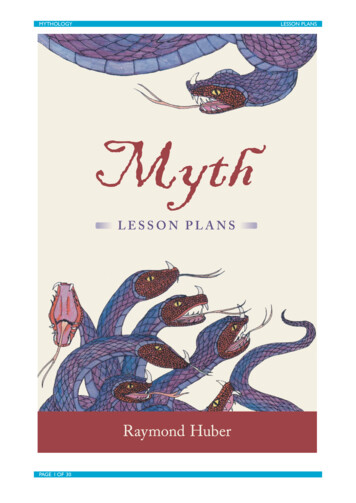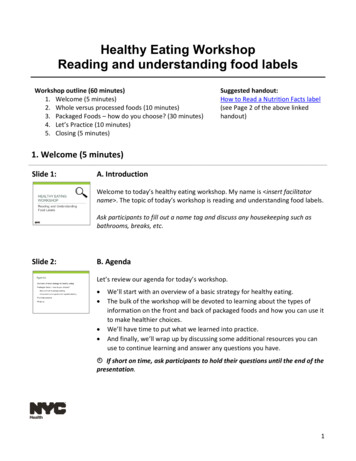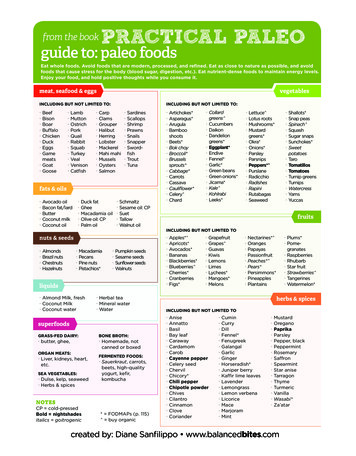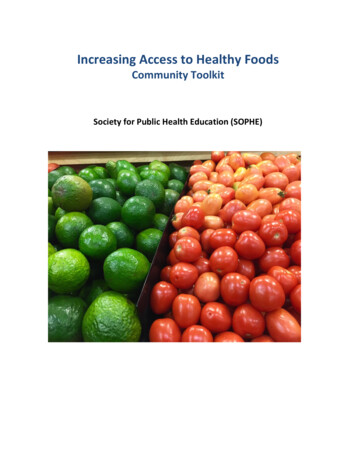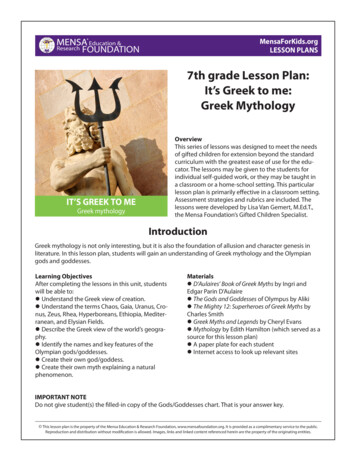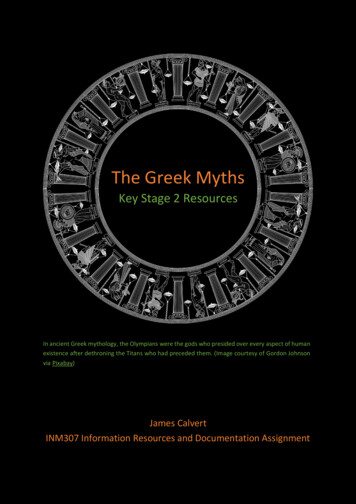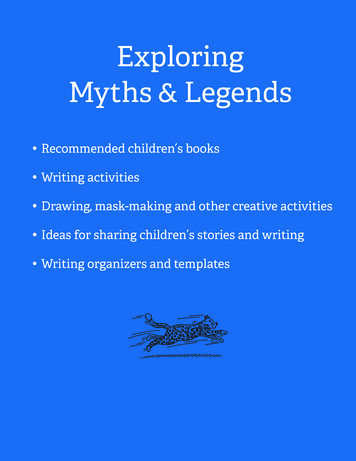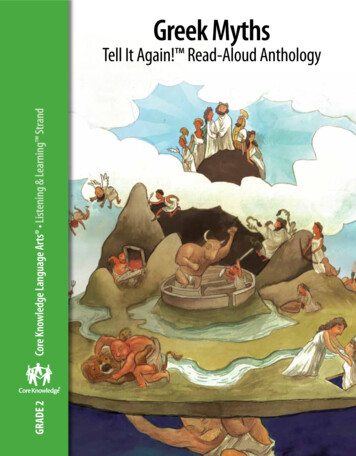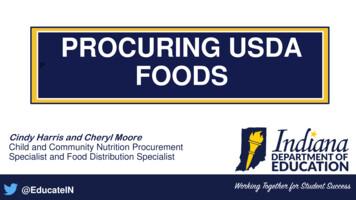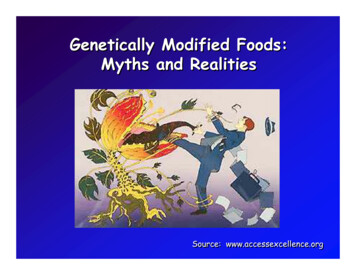
Transcription
Genetically Modified Foods:Myths and RealitiesSource:Source: www.accessexcellence.orgwww.accessexcellence.org
MiracleMiracle foodsfoods forfor aa hungryhungry d/http://scope.educ.washington.edu/gmfood/
.or.or publicpublic //www.foeeurope.org/press/eric01.jpg
Questions:What’s a GMO?Are GMOs new?Are GM foods safe to eat?Are GM crops safe to grow?
Question: What’s a GMO? AA GMOGMO isis aa “genetically“genetically modifiedmodified organism”organism” TodayToday thisthis meansmeans aa cropcrop plantplant withwith extraextra genesgenes
Question: Are GMOs new? GMGM meansmeans “genetically“genetically modified”modified” AllAll humanhuman foodfood cropscrops areare geneticallygenetically modifiedmodified ToTo survivesurvive inin thethe wild,wild, plantsplants mustmust scatterscatter seedsseeds ForFor peoplepeople toto harvestharvest seeds,seeds, theythey havehave toto stickstick
ydza.org.pl/images/teosinte1.jpgCorn: a “traditional” 202AltD.jpg
Familiar genetically modified a.tamu.edu/kcchome/homeowner/riored.htm
Today’sToday’s GMOGMO aa cropcrop plantplant withwith extraextra genesgenes TheThe extraextra genesgenes werewere addedadded usingusing recombinantrecombinantDNADNA techniquestechniques ChangingChanging plantsplants withwith recombinantrecombinant DNADNA techniquestechniquesisis calledcalled “genetic“genetic engineering”engineering”
PlasmidMakingrecombinantDNAForeign DNADNA is cutwith EcoRISticky endsDNA ligaseSource:Source: www.accessexcellence.orgwww.accessexcellence.org
Source:Source: cterial transformationAntibiotic sensitivebacterial cellCaCl2 treatmentto permeabilizecell wallsSelection on bacterial growth mediumcontaining appropriate antibioticAdd plasmid DNA“Transformed“ bacterial cellMaking many copies of the recombinant DNA
Agrobacterium: nature’s genetic engineerAgrobacterium is the causative agent of galls
Introducing genes using the Ti plasmidNEW GENETi plasmidT-DNAPlant’s DNAAgrobacteriumNucleusPlant cell
The new gene is integrated into the plant’s DNANEW GENEPlant’s DNANucleusPlant cell
Here’s how it looks in the laboratory
A plant with a new gene added
Molecular methods in plant improvementToday: Insect resistant plants Herbicide-tolerant plants Virus resistant plants Vitamin A- and iron-enriched rice
The story of papayaringspot apaya/Top.htm
The story of papayaringspot virus
The story of papayaringspot virus1980s:1980s: PRSV-resistancePRSV-resistance projectproject startsstarts underunder directiondirection ofof DennisDennis GonsalvesGonsalves1991:1991: FirstFirst transgenictransgenic PRSV-resistantPRSV-resistant papayapapaya plantplant1992:1992: PRSVPRSV discovereddiscovered inin PunaPuna districtdistrict1992:1992: FirstFirst fieldfield trialstrials PRSV-resistantPRSV-resistant papayapapaya plantsplants1994:1994: USDAUSDA grantsgrants permissionpermission forfor largelarge scalescale fieldfield trialstrials1995-97:1995-97: ApprovalsApprovals forfor releaserelease fromfrom USDA,USDA, EPA,EPA, FDAFDA1992-1997:1992-1997: PRSVPRSV takestakes itsits toll;toll; manymany farmersfarmers gogo outout ofof businessbusiness1998:1998: SeedsSeeds released,released, freefree ofof charge,charge, toto growersgrowers2000:2000: PapayaPapaya industryindustry bouncesbounces back;back; cropcrop backback toto prepre 19951995 levelslevels
The story of papayaringspot apaya/Top.htm
Bt cornhttp://dragon.zoo.utoronto.ca/ .ca/ jlm-gmf/T0201A/corn1.jpgFusariumFusarium earear rotrot producesproduces fumonisinsfumonisinsKernelKernel rotrot producesproduces .JPG
Bt cornhttp://dragon.zoo.utoronto.ca/ .ca/ jlm-gmf/T0201A/corn1.jpgFusariumFusarium earear rotrot producesproduces fumonisinsfumonisinsKernelKernel rotrot producesproduces .JPG
Molecular methods in plant improvementTomorrow: Nutritionally enhanced crops Anti-cancer substances Edible vaccines Antibodies from plants Biodegradable plastics New biomaterials Disease-resistant plants Spoilage-resistant seeds and tubers Stress-resistant crops High-yielding pseudo C44 rice
Golden riceRice with vitamin A and iron
Are GM foods safe to eat? Is DNA safe to eat? Could antibiotic genes get into people? Could GM foods contain new toxins? Could GM foods cause allergies?
Are GM foods safe to eat? Is DNA safe to eat?All foods contains DNA -- about a teaspoon of DNA in a pound of foodAdding one gene adds roughly 1 part in a million or 0.0001%DNA is digested starting in your mouthTiny fragments gets through the digestive processThis is always happening when we eat foodIt doesn’t change our genes
Are GM foods safe to eat? Could antibiotic resistance genes get into people?No, DNA is broken down into tiny pieces in our digestive tracts Could they get into other bacteria in the gut?Bacteria take up DNA very rarelyTransfers to gut bacteria have been looked for, but not found
Are GM foods safe to eat? Could GM foods contain new toxins?Plants contain chemicals that are toxic -- in large amountsThe FDA requires chemical analyses and toxicity studiesGM foods are better analyzed than any in human history
Are GM foods safe to eat? Could GM foods cause allergies? Allergy factsMost food allergies are caused by about half a dozen proteinsFoods contain more than 100,000 different proteinsThe FDA requires developers to identify allergenicity potential
What’s the bottom line?A GM food is less likely to cause a problemthan any new food you’ve ever tried
Are GM crops safe to grow? Could genes escape from crops to cause problems? Will GM crops reduce biodiversity?
Could genes escape from crops to cause problems?Gene transfer from crops to other plants is now called “gene flow”Gene flow occurs between members of the same speciesGene flow is not a new problem in agriculture What kinds of problems does gene flow cause?It depends on the crop
Will GM crops reduce biodiversity?The monarch butterfly incidentBt genes in Mexican land es/997 97 0.jpg
Will GM crops reduce biodiversity?“Nothing has driven more species to extinction or caused moreinstability in the world’s ecological systems than the developmentof an agriculture sufficient to feedfeed 6.36.3 billionbillion people.”people.”“To assert that GM techniques are a threat to biodiversity is to statethe exact opposite of the truth.”“The less focused and productive this agriculture is, the moredestructive its effects will be.”PeterPeter Raven,Raven, DirectorDirector ofof thethe MissouriMissouri BotanicalBotanical GardenGarden
Why are attitudes toward GM foods so negative?
Does it matter whether we accept GM crops?“You people in the developed world are certainly free to debate themerits of genetically modified foods, but can we please eat first?”-- Florence Wambugu, 2003
Today's GMO a crop plant with extra genes Today's GMO a crop plant with extra genes The extra genes were added using recombinant
